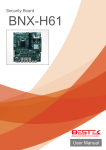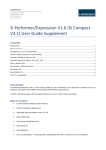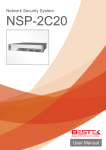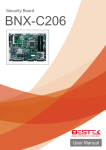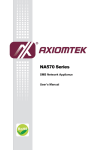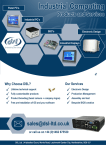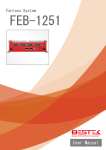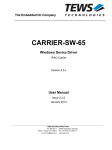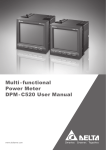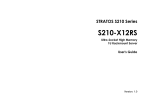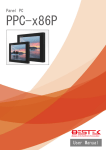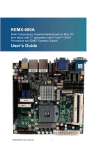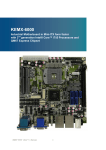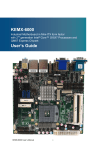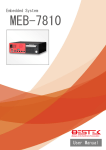Download User Manual
Transcript
Network Security System NSP-10H6 Always at the forefront of innovation User Manual 1 Copyright This publication contains information that is protected by copyright. No part of it may be reproduced in any form or by any means or used to make any transformation adaptation without the prior written permission from the copyright holders. This publication is provided for informational purposes only. The manufacturer makes no representations or warranties with respect to the contents or use of this manual and specifically disclaims any express or implied warranties of merchantability or fitness for any particular purpose. The user will assume the entire risk of the use or the results of the use of this document. Further, the manufacturer reserves the right to revise this publication and make changes to its contents at any time, without obligation to notify any person or entity of such revisions or changes. © 2011. All Rights Reserved. Trademarks All trademarks and registered trademarks of products appearing in this manual are the properties of their respective holders. FCC and DOC Statement on Class A This equipment has been tested and found to comply with the limits for a Class A digital device, pursuant to Part 15 of the FCC rules. These limits are designed to provide reasonable protection against harmful interference when the equipment is operated in a residential installation. This equipment generates, uses, and can radiate radio frequency energy and, if not installed and used in accordance with the instruction manual, may cause harmful interference to radio communications. However, there is no guarantee that interference will not occur in a particular installation. If this equipment does cause harmful interference to radio or television reception, which can be determined by turning the equipment off and on, the user is encouraged to try to correct the interference by one or more of the following measures: Reorient or relocate the receiving antenna. Increase the separation between the equipment and the receiver. Connect the equipment into an outlet on a circuit different from that to which the receiver is connected. Consult the dealer or an experienced radio TV technician for help. Notice: 1. The changes or modifications not expressly approved by the party responsible for compliance could void the user’s authority to operate the equipment. 2. Shielded interface cables must be used in order to comply with the emission limits. 2 Warranty 1. Warranty does not cover damages or failures that are raised from misuse of the product, inability to use the product, unauthorized replacement or alteration of components and product specifications. 2. The warranty is void if the product has been subject to physical abuse, improper installation, modification, accidents or unauthorized repair of the product. 3. Unless otherwise instructed in this user’s manual, the user may not, under any circumstances, attempt to perform service, adjustments or repairs on the product, whether in or out of warranty. It must be returned to the purchase point, factory or authorized service agency for all such work. 4. We will not be liable for any indirect, special, incidental or consequential damages to the product that has been modified or altered. Static Electricity Precautions It is quite easy to inadvertently damage your PC, system board, components or devices even before installing them in your system unit. Static electrical discharge can damage computer components without causing any signs of physical damage. You must take extra care in handling them to ensure against electrostatic build-up. 1. To prevent electrostatic build-up, leave the system board in its anti-static bag until you are ready to install it. 2. Wear an antistatic wrist strap. 3. Do all preparation work on a static-free surface. 4. Hold the device only by its edges. Be careful not to touch any of the components, contacts or connections. 5. Avoid touching the pins or contacts on all modules and connectors. Hold modules or connectors by their ends. Important: Electrostatic discharge (ESD) can damage your processor, disk drive and other components. Perform the upgrade instruction procedures described at an ESD workstation only. If such a station is not available, you can provide some ESD protection by wearing an antistatic wrist strap and attaching it to a metal part of the system chassis. If a wrist strap is unavailable, establish and maintain contact with the system chassis throughout any procedures requiring ESD protection. 3 Safety Measures To avoid damage to the system: • Use the correct AC input voltage range. To reduce the risk of electric shock: • Unplug the power cord before removing the system chassis cover for installation or servicing. After installation or servicing, cover the system chassis before plugging the power cord. Battery: • Danger of explosion if battery incorrectly replaced. • Replace only with the same or equivalent type recommend by the manufacturer. • Dispose of used batteries according to local ordinance. Before Using the System Before using the system, prepare basic system components. If the system comes as a barebone; that is, none of the key components, including processor, memory, and hard drive has been pre-installed as part of your purchase, you will need to at least ensure a compatible counterpart is located and installed. You will also need a few external system peripherals intended for the use of the system, a common pool with at least a keyboard, a mouse, and a monitor is thus suggested. 4 Table of Content Copyright................................................................................................................................................................. 2 Trademarks.............................................................................................................................................................. 2 FCC and DOC Statement On Class A .........................................................................................................................2 Warranty ..................................................................................................................................................................3 Static Electricity Precautions ....................................................................................................................................3 Safety Measures .......................................................................................................................................................4 Before Using the System Board ................................................................................................................................4 Table of Content .......................................................................................................................................................5 Chapter 1 General Information 1.1 Main Feature ......................................................................................................................................................7 1.2 Specifications .................................................................................................................................................... 8 1.3 Optional LAN Modules ..................................................................................................................................... 9 1.4 System Layout.................................................................................................................................................. 10 1.5 Indicators and Features .................................................................................................................................. 11 Chapter 2 Preparation 2.1 Before You Begin ....................................................................................................................................... 14 2.2 Precautions ..................................................................................................................................................... 14 2.3 Open Up Top Cover.......................................................................................................................................... 15 2.4 Accessing Processor & Memory........................................................................................................................ 16 2.5 Adding 2.5”/3.5” SATA Hard Drive..................................................................................................................... 16 2.6 Accessing CompactFlash Card ........................................................................................................................ 18 Chapter 3 Operation 3.1 Turning On The System .................................................................................................................................... 20 3.2 Installing Operating System & Drivers ........................................................................................................ 21 3.3 Understanding LED Indicators ........................................................................................................................ 22 Chapter 4 BIOS Setup 4.1 Entering Setup................................................................................................................................................. 25 4.2 Getting Help .................................................................................................................................................... 25 4.3 Control Keys .................................................................................................................................................... 25 4.4 The Main Menu ............................................................................................................................................... 26 4.5 The Advanced Menu........................................................................................................................................ 27 4.6 The Chipset Menu.................................................................................................................................................. 30 4.7 The Boot Menu................................................................................................................................................ 31 4.8 The Security Menu .......................................................................................................................................... 33 4.9 The Save & Exit Menu ..................................................................................................................................... 34 Chapter 5 Programming Guide ............................................................................................. 36 Chapter 6 Q&A..................................................................................................................... 38 5 Chapter 1 General Information 6 1.1 Main Feature Processor Performance NSP-10H6 is a 1U Rack Mount Network Security System that, pre-installed with BNX-H61 security board, featuring on Intel® H61 chipset, supports Intel® Gen-2/3 LGA1155 Celeron®, Pentium®, Core®-i3/i5/i7 processors that carry the built-in Intel® HD Graphic engine. Below is a brief list of available processors as a quick reference: Celeron® Processor: G540/G1620 Pentium® Processor: G850/G2120 Core®-i3 Processor: i3-2120/i3-3220 Core®-i5 Processor: i5-2400/i5-3550S Core®-i7 Processor: i7-2600/i7-3770 8GB Memory for 64bit OS The two Dual Channel DDR3 DIMM slots are designed to carry up to 16GB DDR3 1066/1333/1600MHz SDRAM with Non-ECC support, ideally facilitating applications that demand total memory capacity for the use of 64bit OS, beyond the 4GB barrier inherent in the 32bit OS. Onboard/Module Gigabit LAN Ports The six onboard Intel® PCIe Gigabit 82583V LAN Controllers deliver outstanding network performance with 2-pair dual-latch bypass functions that are configurable through BIOS setting or software programming and are under visual monitoring via the LED indications at front panel. Yes further access to full status is also available via software programming. One expansion slot is designed to make the unit expandable up to additional 4-port copper (RJ45) Gigabit ports or 4-port fiber (SFP) Gigabit ports, both on Intel® 82580EB chip, maximizing the system up to a total 10-port Gigabit Ports, only within a 1U rack mount enclosure. Below is a list of all available LAN modules: 4-Port RJ45 Gigabit LAN Module on Intel® 82580EB 4-Port SFP Gigabit LAN Module on Intel® 82580EB List of Key Features Intel® H61 Chipset Intel® LGA1155 Gen-2/3 Desktop Celeron®, Pentium®, Core®-i3/i5/i7 Processor Two DDR3 RAM Slots up to 16GB One internal 3.5” SATA Drive, or two internal 2.5” SATA Drives One CompactFlash Socket One SATADOM Port One DB15 VGA at rear side Two USB 2.0 Ports at front Six Intel® Gigabit LAN Ports at front One RJ45 Console Port at front One Expansion Slot for up to additional 4-Port Gigabit LAN Module 1U 300W Flex-ATX Power Supply 1U Rack Mount of 365mm Depth 7 1.2 Specifications Core Engine Chipset Intel® H61 PCH Processor Support Intel® Gen-2/3 LGA1155 Processor Memory 2x DDR3-1066/1333/1600 DIMM Slots for up to 16GB Display CPU Integrated (Intel® HD Graphics 2500/4000) Controller 6x Onboard Intel® 82583V GbE Controllers ByPass 2-Pair Dual-Latch LAN Module Support 1x PCIe X8 Slot for LAN Module SATA 1x 3.5” (or 2x 2.5”) SATA2 Drive Bay SATADOM 1x SATADOM Socket CF 1x CompactFlash Socket Indication 1x Power LED, 1x HDD LED, 2x Bypass LED LAN 6x RJ45 Ports Console 1x RJ45 Type Console Port USB 2x USB 2.0 Ports Switch 1x Rock Type Power Switch VGA 1x Optional DB15 VGA Port Expansion PCIe 1x Straddle Type PCIe X8 Slot Power Type Internal 300W Single Power Supply, 100-240Vac, 50-60Hz Cooling CPU Fan 1x CPU Cooler with Blower Fan System Fan 2x 40mm System Fans at rear side Other H/W Monitoring Monitor temperature, voltage, and fan speed, auto-throttling control at CPU overheat LCM Character Type 1x Optional 2x16 LCM with 5x Programmable Keys Operating Temp. 0oC ~ 40oC Storage Temp. -20oC ~ 70oC Humidity 10% ~ 90% (Non-Condensing) Dimension 430mm (W) x 365mm (D) x 44mm (H) Ethernet Storage Front I/O Rear I/O Environment Mechanical 8 1.3 Optional LAN Modules BEM-C600-580-C4 BEM-C600-580-F4 Type LAN Module Chipset Intel® 82580EB Interface PCIe X4 Network Port Four RJ45 Gigabit Bypass 1-Pair Type LAN Module Chipset Intel® 82580EB Interface PCIe X4 Network Port Four SFP Fiber Gigabit 9 1.4 System Layout Figure 1.1: System Layout of NSP-10H6 10 1.5 Indicators & Features ►Front View With 4-Port RJ45 LAN Module With 4-Port SFP LAN Module 11 ►Rear View 12 Chapter 2 Preparation 13 2.1 Before You Begin A stable and clean working environment are essential. Dust and dirt can get into components and cause a malfunction. Use containers to keep small components separated. Adequate lighting and proper tools can prevent you from accidentally damaging the internal components. Most of the procedures that follow require only a few simple tools, including the following: A Philips screwdriver A flat-tipped screwdriver A set of jewelers Screwdrivers A grounding strap An anti-static pad Using your fingers can disconnect most of the connections. It is recommended that you do not use needle-nosed pliers to disconnect connections as these can damage the soft metal or plastic parts of the connectors. Before working on internal components, make sure that the power is off. Ground yourself before touching any internal components, by touching a metal object. Static electricity can damage many of the electronic components. Humid environment tend to have less static electricity than dry environments. A grounding strap is warranted whenever danger of static electricity exists. 2.2 Precautions Computer components and electronic circuit boards can be damaged by discharges of static electricity. Working on the computers that are still connected to a power supply can be extremely dangerous. Follow the guidelines below to avoid damage to your computer or yourself: Always disconnect the unit from the power outlet whenever you are working inside the case. If possible, wear a grounded wrist strap when you are working inside the computer case. Alternatively, discharge any static electricity by touching the bare metal chassis of the unit case, or the bare metal body of any other grounded appliance. Hold electronic circuit boards by the edges only. Never touch the components on the board unless it is necessary to do so. Do not flex or stress the circuit board. Leave all components inside the static-proof packaging that they shipped with until they are ready for installation. Use correct screws and do not over tighten screws. 14 2.3 Open Up Top Cover This is the first step of all to proceed with, if you are to install (or change) a processor (hard drive or memory module). Please remove the 2 screws at the back as indicated in the places below, prior to any moving of the top cover. It is recommended to push the top cover backwards so as to detach the cover tongue out of the snatch-up at front side, before the lift-up or removal of the top cover. Securing the screws is essential for they would be re-used for the restoration of the top cover, after all preparation procedures are completed. 15 2.4 Accessing Processor & Memory Please refer to the Manual of BNX-H61 motherboard for substantial details as to adding processor, cooler, and memory. 2.5 Adding 2.5”/3.5” SATA Hard Drive Procedures: (1) Turn off the system and open up the top cover. (2) Find the four screws fastened on the Hard Drive bracket (red circles as below). Remove these screws to acquire the Hard Drive bracket. (3) This Hard Drive bracket is designed to hold one 3.5” SATA Drive, with also two smaller L-bracket for two 2.5” SATA Drives. Please find the four screws fastened on the top of the Hard Drive bracket (blue arrows as below) to detach the two smaller L-brackets. 16 (4) Add the 3.5” Hard Drive: As illustrated below, please have the 3.5” Hard Drive assembled with this Hard Drive bracket, leaving the Hard Drive I/O at the end as in the figure below, and add in the suggested numeric sequence the four screws enclosed in the accessory screw bag, for a perfect and firm Hard Drive subset. (5) Add the two 2.5” Hard Drives: As illustrated below, please have the two 2.5” Hard Drive assembled with the two smaller L-brackets, leaving the Hard Drive I/O at either end as the brackets are symmentrically designed, and add the eight screws enclosed in the accessory screw bag, for a perfect and firm Hard Drive subset. In case only one 2.5” Hard Drive is to be installed, add this Hard Drive on either top or bottom position to make the subset. Attach the finished 2.5” subset into the Hard Drive bracket, ensuring HDD Drive I/O are at the similar position as in the 3.5” Hard Drive section, and add the four screws from the top to complete the job. (6) Restore this Hard Drive subset back to the chassis, assure the Hard Drive I/O side face to the power supply unit, and add the four screws back to position. (7) Add SATA signal cable and SATA power cable to complete the work. 17 2.6 Accessing CompactFlash Card CompactFlash instead of CFast NSP-10H6 comes with one CompactFlash card socket, rather than CFast card socket. Please be careful when adding your flash devices. Procedures: (1) (2) (3) (4) Turn off the system. The onboard CompactFlash socket can be located on motherboard (as the red circle). Please detach the Hard Drive bracket before inserting, removing, or swapping a CompactFlash. Restore Hard Drive bracket if needed. Please be advised that CompactFlash card on IDE interface is never to be added or removed when the system power is still turned on; that is, no plug-and-play scheme is enabled for this device. Disrespect of such a limitation would very likely lead to system instability or malfunction, or even to the worst a fatal system catastrophe. Please always turn off system power before accessing CompactFlash card. 18 Chapter 3 Operation 19 3.1 Turning On The System Add your cables, such as USB keyboard, USB mouse, and DB15 VGA Cable as the merest devices to control the system. Watch Input AC Power Range Please leave the AC power cord as the last cable to be added, right on the AC Inlet as indicated below with blue circle. The AC input range of the built-in Power Supply is 100-240Vac. If your AC input is not within this range, though rarely possible in fact, it is not compliant with the system and you should not plug in the AC power cord. System Is Up On AC Power In some cases, depending on whether a BIOS setting has been configured to allow immediate power-on upon the delivery of AC power, system might come right up unexpectedly for no particular reason. Please refer to BIOS section for details with “Restore On AC Power Loss”. Have you wish to bring it down, simply press once on the power switch (located next to power supply with yellow circle), or press and hold for 4 seconds, to reach that goal. However, in most occasions, without such abrupt event as stated above, simply press once on the Power Switch to turn on the system. Power LED The power LED can be found at front panel and shall come lit constant ON at system start. HDD LED The HDD LED can also be found at front panel and shall blink in the wake of storage activity, such as SATA drive or CompactFlash. First screen & Optimal BIOS Setting Once the system successfully boots up, it shall activate display signal on monitor, disclosing some system information as checkpoints for debugging, thereafter users are encouraged to bring up BIOS setup menu to at least load the optimal BIOS setting, as the first thing to do at power on. Please refer to the BIOS section for substantial details. 20 3.2 Installing Operating System & Drivers Confirm the Hard Drive List The system is designed to allow booting from a variety of internal devices, including USB pen drive, SATA drive, and CompactFlash drive, etc. Given the tiny footprint and slow performance of USB pen drive, SATA drive and CompactFlash are more likely the devices to carry operating system and can be found in the detected drive list, in the section of SATA Configuration. In the event that a particular SATA device is not detected and prompted in the device list, hardly would the system boot from it. Please turn off the system, check or re-apply the SATA cable and SATA power cable, or re-insert CompactFlash card to ensure an appropriate connection. Always Mind the SATA Mode SATA controller is embedded in the Intel® H61 chipset, and shall run only in one single SATA mode at a time. Two different modes are available: IDE and AHCI. Please ensure that a SATA mode has been selected for the installation, and always use this particular mode to boot the operating system installed on that SATA mode. Failed to boot the operating system with the correct SATA mode would very probably run into system collapse. While thus disaster occurs, please re-select a SATA mode to try again the advisability of such change, so as to recollect the mode being used at the installation phase. Procedures to load operating system: (1) (2) (3) (4) (5) (6) (7) (8) (9) Please attach USB CD-ROM or DVD-ROM drive. Start or restart the system. Press “del” to go to BIOS setup menu. Choose to confirm SATA Controller status. If it is enabled, select a SATA mode and go to (6). If SATA Controller is disabled, bring it up and reboot to allow a re-detection of Hard Drives. Confirm if the Hard Drive has been detected by the prompt of it on the drive list. Scroll and choose to boot from optical device (CD-ROM or DVD-ROM). Save and reboot the system to activate the change and start the installation. Upon reception of messages or instruction from Operating System CD or DVD, please proceed with the rest of the work as installer instructs. Loading Extra Driver Files Some challenges might occur during the installation, as if the issue of no Hard Drive detected, where extra driver files are needed. This is mostly found, when AHCI mode is selected, in operating systems such as Windows-XP, where a USB floppy drive loaded with SATA driver should be prepared and attached on USB port and, at the prompt of such a message, please press “F6” key while being asked to do so, to allow the installer integrate the driver file from floppy drive. Windows-7 or above apparently do not seem to come with such an issue against the onboard Intel® H61 SATA Controller, and hence no extra driver should be needed. On completion of the installation of operating system such as Microsoft Windows, please find the driver CD in the enclosed accessory bag and proceed with driver files installation in the sequence as: INF (Chipset), VGA, and LAN. If some driver updates are available by Windows Update, please accept the updates when prompted. 21 3.3 Understanding LAN Indicators Activity LED The left LED is LAN Port Activity LED, with three different indication status: (1) Constant Yellow: Network is connected. (2) Blinking Yellow: Network activity is on-going. (3) Off: Network is not connected. LAN Speed LED The right LED is LAN Port Speed LED, with three different speeds: (1) Amber: 1000 Speed (2) Green: 100 Speed (3) Off: 10 Speed. Summary Table LED Color Yellow Yellow Off Amber Green Off RJ45 NIC Linkage (Left Side) RJ45 NIC Mode (Right Side) State On Blinking Off On On Off Description LAN linked LAN accessing No LAN linked Gigabit mode 100M mode 10M mode ByPass LAN LED Both Bypass LED would be constantly On as Yellow for Bypass mode (Bypass is enabled), or Off for PassThrough mode (Bypass is disabled). Such Bypass LEDs would lit the same way for both Power On and Power Off mode setting, as long as power cord is plugged at power supply inlet that leads to a standby voltage being held. Bypass Pair #1 #2 Color Yellow Off Yellow Off State Bypass PassThrough Bypass PassThrough 22 Chapter 4 BIOS Setup 23 About the BIOS The BIOS (Basic Input and Output System) Setup program is a menu driven utility that enables you to make changes to the system configuration and tailor your system to suit your individual work needs. It is a ROM-based configuration utility that displays the system’s configuration status and provides you with a tool to set system parameters. These parameters are stored in non-volatile battery-backed-up CMOS RAM that saves this information even when the power is turned off. When the system is turned back on, the system is configured with the values stored in CMOS. With easy-to-use pull down menus, you can configure such items as: Hard drives, diskette drives, and peripherals Video display type and display options Password protection from unauthorized use Power management features When to Run BIOS This program should be executed under the following conditions: When changing the system configurations. When a configuration error is detected by the system and you are prompted to make changes to the Setup program. When resetting the system clock. When setting the CPU clock speed so that it automatically runs either fast or slow. When redefining the communication ports to prevent any conflicts. When making changes to the Power Management configuration. When changing the password or making other changes to the security setup. Normally, CMOS setup is needed when the system hardware is not consistent with the information contained in the CMOS RAM, whenever the CMOS RAM loses power, or when the system features need to be changed. When to Update BIOS In the event that new features are released and a BIOS update is required, you will need to update your BIOS on your own, with the help of an appropriate guide, a reference tool, and some command files for the job. Please seek for help from your local dealer, or send your request to our technical support department. 24 4.1 Entering Setup When the system is powered on, the BIOS will initiate the Power-On-Self-Test (POST) routines. These routines perform various diagnostic checks. If an error is encountered, the error will be reported in one of two different ways: If the error occurs before the display device is initialized, a series of beeps will be transmitted. If the error occurs after the display device is initialized, the screen will display the error message. Powering on the computer and immediately pressing <Del> allows you to enter Setup. Another way to enter Setup is to power on the computer and wait for the following message during the POST: TO ENTER SETUP BEFORE BOOT PRESS <CTRL-ALT-ESC> OR <DEL> KEY Press the <Del> key or press the <Ctrl>, <Alt>, and <Esc> keys to enter Setup. 4.2 Getting Help The online description of the highlighted setup item is displayed at the right pane of the menu at all time. Press F1 to pop up a small help window that lists all the function keys and its use. To exit the Help Window, press <F1> or <Esc>. 4.3 Control Keys The table below lists all the function keys for the navigation in the BIOS setup menu. Function Key Description Up/Down Arrow Key Move Up/Down Left/Right Arrow Key Move Left/Right Enter Key Select +/- Key Change value ESC Exit Tab Select a Field F1 General Help F10 Save & Exit To exit the Help Window, press <F1> or <Esc>. 25 4.4 The Main Menu Figure 4-1: BIOS Setup Utility Main Menu The menu bar on the top of the first screen has the following submenus: Main: Basic system configuration. Advanced: Advanced system settings. Chipset: Other functions. Boot: System boot configuration. Security: Configure Supervisor and User Password Save & Exit: Exit options as well as loading optimal defaults System Time [xx:xx:xx]: Set the system time. System Date [Day xx/xx/xxxx]: Set the system date. 26 4.5 The Advanced Menu In this section, you may set the configurations for the following items: RTC Wake Settings, Trusted Computing, CPU Configuration, SATA Configuration, Super IO Configuration, H/W Monitor, Chassis Function, and Serial Port Console Redirection. S5 RTC Wake Settings Resume On RTC Alarm When [Enabled], you can set the date and time at which the RTC (real-time clock) alarm wakes up the system from suspend mode. 27 Trusted Computing TPM Support This setting controls the Trusted Platform Module (TPM) designed by the Trusted Computing Group (TCG). TPMs are special-purpose integrated circuits (ICs) built into a variety of platforms to enable strong user authentication and machine attestation -- essential to prevent inappropriate access to confidential and sensitive information and to protect against compromised networks. TPM State This setting indicates the TPM state. Pending TPM Operation This function is used to select a TPM command to be issued during the next boot. CPU Configuration CPU Configuration This menu shows the CPU information. Read only. Limit CPUID Maximum It is designed to limit the listed speed of the processor to older operating systems. Execute Disable Bit It can prevent certain classes of malicious “buffer overflow” attacks where worms can try to execute code to damage your system. It is recommended you keep this enabled always. SATA Configuration SATA Mode Selection Select a proper SATA mode from IDE or AHCI mode. Super IO Configuration Serial Port 0/1 Configuration Serial Port This setting enables/disables the specified serial port. Device Settings This setting shows the address & IRQ settings of the specified serial port. 28 PC Health Status These items display the current status of all of the monitored hardware devices/components such as CPU voltage, temperatures and all fans’ speeds. Chassis Intrusion This setting enables/disables the feature of recording the chassis intrusion status and issuing a warning message if the chassis is once opened. To clear the warning message, set the field to [Reset]. The setting of the field will automatically return to [Enable] later. Serial Port Console Redirection Console Redirection Enables or disables Console Redirection function of each Serial Port. Console Redirection Settings Terminal Type To operate the system’s console redirection, you need a terminal supporting ANSI terminal protocol and a RS-232 null modem cable connected between the host system and terminal(s). This setting specifies the type of terminal device for console redirection. Bits per second, Data Bits, Parity, Stop Bits This setting specifies the transfer rate (bits per second, data bits, parity, stop bits) of Console Redirection. Flow Control Flow control is the process of managing the rate of data transmission between two nodes. It’s the process of adjusting the flow of data from one device to another to ensure that the receiving device can handle all of the incoming data. This is particularly important where the sending device is capable of sending data much faster than the receiving device can receive it. Recorder Mode, Resolution 100x31 These settings enable/disable the recorder mode and the resolution 100x31. Legacy OS Redirection Resolution This setting specifies the redirection resolution of legacy OS. 29 4.6 The Chipset Menu Intel PCH PC Version / SKU Name / Rev ID These items show the chipset information of PCH PC Version, SKU Name and Rev ID. Restore On AC Power Loss This setting specifies whether your system will reboot after a power failure or interrupt occurs. Available settings are: [Power Off] Leaves the computer in the power off state. [Power On] Leaves the computer in the power on state. [Last State] Restores the system to the previous status before power failure or interrupt occurred. Watchdog Time Out Event This setting controls the Watchdog Time Out event. LAN1&2 / LAN3-6 ByPass state @ Power On / Off LAN Bypass removes a single point of failure so that essential bus3-13ness communication can continue while a network failure is diagnosed and resolved. In the event of a power, hardware or software failure, Hardware Bypass will automatically activate, allowing network traffic to continue. Traffic between the LAN and WAN is allowed without interruption. 30 4.7 The Boot Menu Bootup NumLock State This setting is to set the Num Lock status when the system is powered on. Setting to [On] will turn on the Num Lock key when the system is powered on. Setting to [Off] will allow users to use the arrow keys on the numeric keypad. Fast Boot This BIOS feature determines if the BIOS should hide the normal POST messages with the motherboard or system manufacturer’s full-screen logo. When it is enabled, the BIOS will display the full-screen logo during the boot-up sequence, hiding normal POST messages. When it is disabled, the BIOS will display the normal POST messages, instead of the full-screen logo. Please note that enabling this BIOS feature often adds 2-3 seconds of delay to the booting sequence. This delay ensures that the logo is displayed for a sufficient amount of time. Therefore, it is recommended that you disable this BIOS feature for a faster boot-up time. 31 Set Boot Priority This setting allows users to set the sequence of boot devices where BIOS attempts to load the disk operating system. Boot Option Priorities The items allow you to set the sequence of boot devices where BIOS attempts to load the disk operating system. First press <Enter> to enter the sub-menu. Then you may use the arrow keys ( ↑↓ ) to select the desired device, then press <+>, <-> or <PageUp>, <PageDown> key to move it up/down in the priority list. CSM Parameters This setting specifies the parameters for Compatibility Support Module, a part of the Intel Platform Innovation Framework for EFI providing the capability to support legacy BIOS interfaces. USB KEY Drive BBS Priorities This setting allows users to set the USB key boot sequence. UEFI Boot Drive BBS Priorities This setting allows users to set the UEFI boot drive sequence. 32 4.8 The Security Menu Administrator Password Administrator Password controls access to the BIOS Setup utility. Users will be prompted for Administrator password only when they enter BIOS Setup. User Password User Password controls access to the system at boot and access to the BIOS Setup utility. Users will be prompted for User password when they power on the system or enter BIOS Setup. In BIOS Setup, users will have Administrator rights. 33 4.9 The Save & Exit Menu Save Changes and Exit Save changes to CMOS and exit. Discard Changes and Exit Abandon all changes and exit. Save Changes and Reset Save changes to CMOS and reset the system. Discard Changes and Reset Abandon all changes and reset the system. Restore Defaults Restore the preset defaults. 34 Chapter 5 Programming Guide 35 For example to compress it by executing “RU” under DOS could reference as below, and if users need to build codes for other OS environment, please consult OS distributor accordingly. IOSpace 0x50D bit6 SB_GPIO14 (Send bit) IOSpace 0x539 bit2 SB_GPIO42 (WDT 0:Reboot/1:Bypass) IOSpace 0x539 bit3 SB_GPIO43 (Power Off : 0:PassTru /1:Bypass) IOSpace 0x50D bit1 SB_GPIO9 (Power On : 0:PassTru /1:Bypass) IOSpace 0x539 bit6 PAIR1 SB_GPIO46 IOSpace 0x539 bit5 PAIR2 SB_GPIO45 PAIR3 SB_GPIO44 IOSpace 0x539 bit4 PAIR3..1 Ex: [PAIR3..1] 000 : Select LAN 1&2 Channel Control [PAIR3..1] 001 : Select 1. Press “Alt+C” -> Select “IO Space”-> Select “0” -> key in “500” -> press Enter 2. Select Offset “39” Bit2 set to “1” (WDT Bypass) 3. Clean Pair1~3: Select Offset “39” Bit04, 05, 06: Set “0” 4. Select Offset “0D” Bit06 set to “1” -> Bit07 set to “0” (Send bit High -> Low) 5. Select Offset “39” Bit06 set to “1” 6. Repeat setup “4” Enable WDT, and setup time 7. Press “Alt+C” -> Select “ISA” -> key in “4E” -> press Enter -> key in “4F” 8. Press “Ctrl+O” -> key in “o 4E 87” -> press “Enter” -> key in “o 4E 87” -> press “Enter” -> press “ESC” key 9. Press F7 to display 8bit mode -> Select Offset 07 -> set to “07” 10. Offset 30 -> set to “01” 11. Offset F0 -> set to “81” 12. Offset F6 -> set to “3C” Time of watchdog timer 13. Offset F5 -> set to “73” 36 Chapter 6 Q & A 37 Q: The power switch is pressed, but nothing happens. A: Please check the following before you call out for help: (1) Loose AC Power Cord => Push again. (2) Loose power cable (both 24-pin and 4-pin) => Push again. (3) A bad or loose power switch => Reseat the power switch on the header again. Q: I can turn on the power, but the motherboard does not boot. A: Please check the following before you call out for help: (1) (2) (3) (4) (5) (6) Unevenly populated memory modules on the slots => Re-populate the memory module again. Unevenly seated CPU on the socket => Reseat the CPU again. CMOS checksum error => Clear CMOS or reseat the CMOS battery again. Bad Hard Drive => Remove SATA signal cable or CompactFlash card and boot again. Bad PCI card or riser card => Remove PCI card and/or PCI riser card and boot again. Bad external devices => Detach RS-232 cable, LAN cable, and USB cable, and boot again. Q: BIOS POST prompts but gets stuck. A: Please check the following before you call out for help: (1) CMOS checksum error due to Clear CMOS approach => Press F1 to bring up BIOS setup menu and load optimal setting. (2) Bad Hard Drive => Remove SATA signal cable or CompactFlash card and boot again. (3) Bad external devices => Detach RS-232 cable, LAN cable, and USB cable, and boot again. Q: Power LED on power switch is not lit on A: Please reseat the power switch and try again. Q: HDD LED does not blink A: Please reseat the HDD LED and try again. Q: USB Keyboard does not work at DOS mode. A: Please check the following before you call out for help: (1) Check if USB keyboard is well plugged on USB port. (2) Go to BIOS setup menu, Advanced/USB Configuration, and make sure Legacy USB Support is enabled. 38 Q: System does not boot from USB CD-ROM/DVD-ROM A: Please check the following before you call out for help: (1) (2) (3) (4) USB CD-ROM/DVD-ROM is not plugged on USB port. Check in the BIOS that CD-ROM/DVD-ROM has not been detected. Check in the BIOS that CD-ROM/DVD-ROM has not been selected as the first boot device. Unadvised misuse: Some OS installation CD/DVDs, such as Microsoft Windows, have a few seconds waiting time for a keyboard press which triggers the system to boot from the CD-ROM/DVD-ROM. Otherwise, system would boot from internal Hard Drive. Q: System does not boot from USB Pen Drive A: Please check the following before you call out for help: (1) (2) (3) (4) USB Pen Drive is not well plugged on USB port. Check in the BIOS that USB Pen Drive has not been detected. Check in the BIOS that USB Pen Drive has not been selected as the first boot device. Make sure your USB Pen Drive comes with a firmware designed for booting. Q: Windows-XP installer does not find any Hard Drive A: Please check the following before you call out for help: (1) Check in the BIOS that SATA Hard Drive or CompactFlash has been detected. (2) Check in the BIOS for correct SATA mode. If AHCI mode is selected, please refer to Chapter 3 to load extra driver files. Q: Windows does not boot straight forward, and keep rebooting itself or ends at a blue screen A: Please check the following before you call out for help: (1) Incorrect SATA mode => Change mode and boot again. In the case that you need to use a particular SATA mode which was not used for the installation, you need to reinstall your Windows. (2) A wrong image file has been used for cloning. Q: Windows boots, but shuts down prior to showing graphic mode A: Please check the following before you call out for help: (1) Power switch stays at a pressed-down position => bring it up or move it off the header. (2) CPU cooler is not evenly placed on the top of CPU. Overheat issue => Reseat the cooler. (3) No sufficient thermal grease is applied. Overheat issue => Add some more thermal paste. 39 Q: My Windows does not shuts down. It reboots in a few seconds after power off. A: Please check the following before you call out for help: (1) Press and hold the power switch for 4 seconds to see if your system shuts down permanently. (2) Clear CMOS and try again. Q: The display resolution is not right A: Please change the resolution as follows (for Windows) (1) Window-XP: Right-Click on the desktop and select Property for the configuration panel. (2) Windows-7: Right-Click on the desktop and select Resolution for the configuration panel. Q: I cannot connect my network with internet A: Please consult your system administrator to confirm if a static network environment with security port designation has been deployed. Otherwise, mostly, reassuring to have Windows acquiring IP address automatically would be suggested and should resolve the situation. Please be referred to your system administrator for any further network configuration setting. Please also manage to confirm that Bypass function of the port in question is not enabled as this will interrupt the connector between RJ45 port and network chip. Q: Can I enable Bypass function at Power Off mode? A: Yes, you certainly can. NSP-10H6 comes with dual-latch relay that will work at both power on and power off mode. Please bring up the BIOS setup menu to for Bypass configuration. Q: Can I use Console Port at BIOS mode? A: Yes, you certainly can. NSP-10H6 comes with one console port as RJ45 at front side. Please manage to find the console cable in the accessory bag, add the RJ45 end to console port, and the other end to the DB9 RS-232 port of a Windows PC (for example, Windows-XP) that comes with terminal software (for example, Hyper Terminal). To start console function, please make sure console function is enabled, and a proper baud rate is selected. Also of great importance on the terminal software at Windows-PC, a correct serial port has been selected, and a baud rate at which NSP-10H6 has been configured is selected. Upon power on and bringing up BIOS menu, similar message will be popping on terminal pane. Please be noted that no console message will be available on terminal pane out of BIOS (i.e., at run-time), unless user has managed to send console message over the console port by programming. Q: My Windows does not see more than 4GB RAM A: A 32-bit operating system captures only 4GB memory. 40 Q: 4GB RAM is installed, but Windows only sees around 3.0GB capacity. A: Some portion of the system memory will be allocated for system devices, especially the onboard video device. Q: Some onboard devices are not detected in Windows A: Please check the following before you call out for help: (1) Please go to Device Manager to rescan these devices if necessary. (2) If any of the LAN port is not detected (4 of them should be all detected), please go to BIOS setup menu, Advanced/PCIE Ports Configuration, to see if any of them has been disabled. Q: RS-232 Ports do not work A: Please check the following before you call out for help: (1) Please go to Device Manager to see if COM1/COM2 are correctly prompted. (2) Please go to BIOS setup menu, Advanced/Super IO Configuration, to make sure RS-232 port(s) has(have) been enabled. (3) Please double check your RS-232 cable for correct pin definition. 41









































